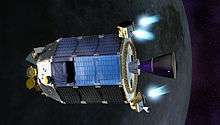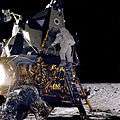Explorer 49
 Artist's impression of Explorer 49 in orbit around the Moon | |
| Mission type | Radio astronomy |
|---|---|
| Operator | NASA[1] |
| COSPAR ID | 1973-039A |
| SATCAT № | 6686 |
| Mission duration | 2 years |
| Spacecraft properties | |
| Launch mass | 328 kilograms (723 lb) |
| Start of mission | |
| Launch date | 10 June 1973, 14:13:00 UTC |
| Rocket | Delta 1913[2] |
| Launch site | Cape Canaveral LC-17B[2] |
| End of mission | |
| Last contact | August 1977 |
| Orbital parameters | |
| Reference system | Selenocentric |
| Periselene | 1,123 kilometers (698 mi) |
| Aposelene | 1,334 kilometers (829 mi) |
| Inclination | 61.3 degrees |
| Epoch | 15 June 1973 |
| Lunar orbiter | |
| Orbital insertion | 15 June 1973, 07:21 UTC |
Explorer 49 (also called Radio Astronomy Explorer-B(RAE-B)) was a 328 kilogram satellite launched on June 10, 1973 for long wave radio astronomy research. It had four 230-meter long X-shaped antenna elements, which made it one of the largest spacecraft ever built.[2]
Launch
Explorer 49 was launched after the termination of the Apollo program, and although it did not examine the Moon directly, it became the last American lunar mission until the launch of Clementine spacecraft in 1994.
Orbit
This mission was the second of a pair of Radio Astronomy Explorer (RAE) satellites, Explorer 38 or RAE-A being the first. Explorer 49 was placed into lunar orbit to provide radio astronomical measurements of the planets, the Sun, and the galaxy over the frequency range of 25 kHz to 13.1 MHz. Since the spacecraft's design used gravity gradient booms, the lumpy lunar gravity field was a problem a for the mission scientists.
Mission
Explorer 49 was placed in lunar orbit to record radio measurements from 25 kHz to 13.1 MHz of the Milky Way galaxy. Explorer 49 was placed in to lunar orbit so that radio waves from earth would not be as big of an interference as Explorer 38 had discovered.
Experiments
The principal investigator for all the experiments was Dr. Robert G. Stone.
1.Step Frequency Radiometers- Explorer 49 was equipped with two Ryle-Vonberg (RV) receivers one on the upper V-antenna and the other on the lower V-antenna.The radiometers were designed to measure at nine frequencies from .45- 9.18 MHz.
2.Rapid-Burst Receivers- Explorer 49 had three rapid burst receivers, one on the upper V-antenna one the lower V-antenna and the third on the middle dipole antenna. The Burst Receivers were composed of a pair of IF Amplifiers and detectors one of the pair was used for back up. They detected on 32-channel's between 25 kHz to 13.1 MHz.
3.Impedance Probe- This was to test the engineering to calibrate the upper V-antenna.
Data
Data were returned to the earth via either a low power UHF/(400 MHz) transmitter, in real time, or stored in an on board tape recorder and transmitted to earth via a high power UHF transmitter (400 MHz). Two tape recorders provided backup storage.
Data collected on explorer 49 was recorded on one of the three 16-mm Micro film (tape recorder) and then was returned to earth through a high power UHF/(400 MHz) transmitter. Also data could be transmitted directly to earth through a low power UHF/(400 MHz) transmitter.
Defects
The third burst receiver on the dipole antenna failed after the first week and no data resulted from the receiver.
Mechanical flaw in the lower V-antenna which caused the leg to only deploy to a length of 183m instead of 229m, it was corrected in November 1974 and extended to the full length of 229m.
See also
References
- ↑ Nick Greene. "Explorer 49 Information". About.com. Retrieved 25 December 2010.
- 1 2 3 Gunter Dirk Krebs. "Explorer: RAE B". Retrieved 25 December 2010.
External links
- Astronautix.com Page on the Radio Astronomy Explorers
- National Space Science Data Center Page on RAE-B (Explorer 49)
- Delta-95, RAE-B Operations Summary
- On Obtaining Lunar Mission Launch Opportunities (Report on Launch/Trajectory planning for the RAE-B mission)
- RAE-B antenna aspect system (Report on the camera system used to verify the antenna deployment of Explorer 49)
- RAE-B antenna aspect processor (Report on the processing hardware for the RAE-B Camera system)
- Proposed gravity-gradient dynamics experiments in lunar orbit using the RAE-B spacecraft
- Scientific instrumentation of the Radio-Astronomy-Explorer-2 Satellite

